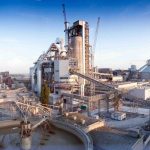Natural gas, colourless highly flammable gaseous hydrocarbon consisting primarily of methane and ethane. It is a type of petroleum that commonly occurs in association with crude oil. A fossil fuel, natural gas is used for electricity generation, heating, and cooking and as a fuel for certain vehicles. It is important as a chemical feedstock in the manufacture of plastics and is necessary for a wide array of other chemical products, including fertilizers and dyes.

The Troll A natural-gas production platform in the North Sea, 80 km (50 miles) northwest of Bergen, Norway. Troll A, the largest movable structure ever built, rests on the seafloor some 300 metres (990 feet) below the surface and rises more than 100 metres (330 feet) above the sea. The platform regulates the recovery of gas from 40 wells located on the seafloor.
Natural gas is often found dissolved in oil at the high pressures existing in a reservoir, and it can be present as a gas cap above the oil. In many instances it is the pressure of natural gas exerted upon the subterranean oil reservoir that provides the drive to force oil up to the surface. Such natural gas is known as associated gas; it is often considered to be the gaseous phase of the crude oil and usually contains some light liquids such as propane and butane. For this reason, associated gas is sometimes called “wet gas.” There are also reservoirs that contain gas and no oil. This gas is termed nonassociated gas. Nonassociated gas, coming from reservoirs that are not connected with any known source of liquid petroleum, is “dry gas.”
History of Use
Discovery and early application
The first discoveries of natural gas seeps were made in Iran between 6000 and 2000 BCE. Many early writers described the natural petroleum seeps in the Middle East, especially in the Baku region of what is now Azerbaijan. The gas seeps, probably first ignited by lightning, provided the fuel for the “eternal fires” of the fire-worshipping religion of the ancient Persians.
The use of natural gas was mentioned in China about 900 BCE. It was in China in 211 BCE that the first known well was drilled for natural gas, to reported depths of 150 metres (500 feet). The Chinese drilled their wells with bamboo poles and primitive percussion bits for the express purpose of searching for gas in limestones dating to the Late Triassic Epoch (about 237 million to 201.3 million years ago) in an anticline (an arch of stratified rock) west of modern Chongqing. The gas was burned to dry the rock salt found interbedded in the limestone. Eventually wells were drilled to depths approaching 1,000 metres (3,300 feet), and more than 1,100 wells had been drilled into the anticline by 1900.
Natural gas was unknown in Europe until its discovery in England in 1659, and even then it did not come into wide use. Instead, gas obtained from carbonized coal (known as town gas) became the primary fuel for illuminating streets and houses throughout much of Europe from 1790 on.
In North America the first commercial application of a petroleum product was the utilization of natural gas from a shallow well in Fredonia, New York, in 1821. The gas was distributed through a small-bore lead pipe to consumers for lighting and cooking.
Improvements in gas pipelines
Throughout the 19th century the use of natural gas remained localized because there was no way to transport large quantities of gas over long distances. Natural gas remained on the sidelines of industrial development, which was based primarily on coal and oil. An important breakthrough in gas-transportation technology occurred in 1890 with the invention of leakproof pipeline coupling. Nonetheless, materials and construction techniques remained so cumbersome that gas could not be used more than 160 km (100 miles) from a source of supply. Thus, associated gas was mostly flared (i.e., burned at the wellhead), and nonassociated gas was left in the ground, while town gas was manufactured for use in the cities.
Long-distance gas transmission became practical during the late 1920s because of further advances in pipeline technology. From 1927 to 1931 more than 10 major transmission systems were constructed in the United States. Each of these systems was equipped with pipes having diameters of approximately 50 cm (20 inches) and extended more than 320 km (200 miles). Following World War II, a large number of even longer pipelines of increasing diameter were constructed. The fabrication of pipes having a diameter of up to 150 cm (60 inches) became possible. Since the early 1970s the longest gas pipelines have had their origin in Russia. For example, in the 1960s and ’70s the 5,470-km- (3,400-mile-) long Northern Lights pipeline was built across the Ural Mountains and some 700 rivers and streams, linking eastern Europe with the West Siberian gas fields on the Arctic Circle. As a result, gas from the Urengoy field, the world’s largest, is now transported to eastern Europe and then on to western Europe for consumption. Another gas pipeline, shorter but also of great engineering difficulty, was the 50-cm (20-inch) Trans-Mediterranean Pipeline, which during the 1970s and ’80s was constructed between Algeria and Sicily. The sea is more than 600 metres (2,000 feet) deep along some parts of that route.

Temane, Mozambique: natural gas pipeline
Natural gas as a premium fuel
As recently as 1960, associated gas was a nuisance by-product of oil production in many areas of the world. The gas was separated from the crude oil stream and eliminated as cheaply as possible, often by flaring (burning it off). Only after the crude oil shortages of the late 1960s and early ’70s did natural gas become an important world energy source (see oil crisis).
Even in the United States the home-heating market for natural gas was limited until the 1930s, when town gas began to be replaced by abundant and cheaper supplies of natural gas, which contained twice the heating value of its synthetic predecessor. Also, when natural gas burns completely, carbon dioxide and water are normally formed. The combustion of gas is relatively free of soot, carbon monoxide, and the nitrogen oxides associated with the burning of other fossil fuels. In addition, sulfur dioxide emissions, another major air pollutant, are almost nonexistent. As a consequence, natural gas is often a preferred fuel for environmental reasons, and it is supplanting coal as a fuel for electric power plants in many parts of the world.



Comments are closed